HYDROMORPHONE HYDROCHLORIDE injection
Hydromorphone Hydrochloride by
Drug Labeling and Warnings
Hydromorphone Hydrochloride by is a Prescription medication manufactured, distributed, or labeled by Hikma Pharmaceuticals USA Inc.. Drug facts, warnings, and ingredients follow.
Drug Details [pdf]
-
HIGHLIGHTS OF PRESCRIBING INFORMATION
These highlights do not include all the information needed to use HYDROMORPHONE HYDROCHLORIDE INJECTION safely and effectively. See full prescribing information for HYDROMORPHONE HYDROCHLORIDE INJECTION.
HYDROMORPHONE HYDROCHLORIDE injection for intravenous, intramuscular or subcutaneous use, CII
Initial U.S. Approval: January 1984WARNING: SERIOUS AND LIFE-THREATENING RISKS FROM USE OF HYDROMORPHONE HYDROCHLORIDE INJECTION
See full prescribing information for complete boxed warning.
- Hydromorphone hydrochloride injection exposes users to risks of addiction, abuse, and misuse, which can lead to overdose and death. Assess patient’s risk before prescribing and reassess regularly for these behaviors and conditions. (5.1)
- Serious, life-threatening, or fatal respiratory depression may occur. Monitor closely, especially upon initiation or following a dosage increase. To reduce the risk of respiratory depression, proper dosing and titration of hydromorphone hydrochloride injection are essential. (5.2)
- Concomitant use of opioids with benzodiazepines or other central nervous system (CNS) depressants, including alcohol, may result in profound sedation, respiratory depression, coma, and death. Reserve concomitant prescribing for use in patients for whom alternative treatment options are inadequate. (5.3, 7)
- If opioid use is required for an extended period of time in a pregnant woman, advise the patient of the risk of Neonatal Opioid Withdrawal Syndrome, which may be life-threatening if not recognized and treated. Ensure that management by neonatology experts will be available at delivery. (5.4)
RECENT MAJOR CHANGES
INDICATIONS AND USAGE
Hydromorphone hydrochloride injection is an opioid agonist indicated for the management of pain severe enough to require an opioid analgesic and for which alternate treatments are inadequate. (1)
LimitationsofUse: (1)
Because of the risks of addiction, abuse, and misuse with opioids, which can occur at any dosage or duration, reserve hydromorphone hydrochloride injection for use in patients for whom alternative treatment options (e.g., non-opioid analgesics or opioid combination products):
- Have not been tolerated, or are not expected to be tolerated
- Have not provided adequate analgesia or are not expected to provide adequate analgesia
Hydromorphone hydrochloride injection should not be used for an extended period of time unless the pain remains severe enough to require an opioid analgesic and for which alternative treatment options continue to be inadequate.
DOSAGE AND ADMINISTRATION
- Hydromorphone hydrochloride injection should be prescribed only by healthcare professionals who are knowledgeable about the use of opioids and how to mitigate the associated risks. (2.1)
- Use the lowest effective dosage for the shortest duration of time consistent with individual patient treatment goals. Reserve titration to higher doses of hydromorphone hydrochloride injection for patients in whom lower doses are insufficiently effective and in whom the expected benefits of using a higher dose opioid clearly outweigh the substantial risks. (2.1, 5)
- Many acute pain conditions (e.g., the pain that occurs with a number of surgical procedures or acute musculoskeletal injuries) require no more than a few days of an opioid analgesic. Clinical guidelines on opioid prescribing for some acute pain conditions are available. (2.1)
- Initiate the dosing regimen for each patient individually, taking into account the patient's underlying cause and severity of pain, prior analgesic treatment and response, and risk factors for addiction, abuse, and misuse. (2.1, 5.1)
- Respiratory depression can occur at any time during opioid therapy, especially when initiating and following dosage increases with hydromorphone hydrochloride injection. Consider this risk when selecting an initial dose and when making dose adjustments. (2.1, 5.2)
- Initial Dosage:
- Hepatic Impairment: Initiate treatment with one-fourth to one-half the usual starting dose, depending on degree of hepatic impairment. (2.3)
- Renal Impairment: Initiate treatment with one-fourth to one-half the usual starting dose, depending on degree of renal impairment. (2.4)
- Do not abruptly discontinue hydromorphone hydrochloride injection in a physically-dependent patient. (2.6, 5.12)
DOSAGE FORMS AND STRENGTHS
- Hydromorphone Hydrochloride Injection, USP, 0.2 mg/mL, 0.5 mg/0.5mL, 1 mg/mL or 2 mg/mL are available in single-dose prefilled syringes. (3)
CONTRAINDICATIONS
- Significant respiratory depression. (4)
- Acute or severe bronchial asthma in an unmonitored setting or in absence of resuscitative equipment. (4)
- Known or suspected gastrointestinal obstruction, including paralytic ileus. (4)
- Known hypersensitivity to hydromorphone, hydromorphone salts, or any other components of the product. (4)
WARNINGS AND PRECAUTIONS
- Opioid-Induced Hyperalgesia and Allodynia: Opioid-Induced Hyperalgesia (OIH) occurs when an opioid analgesic paradoxically causes an increase in pain, or an increase in sensitivity to pain. If OIH is suspected, carefully consider appropriately decreasing the dose of the current opioid analgesic, or opioid rotation. (5.5)
- Life-Threatening Respiratory Depression in Patients with Chronic Pulmonary Disease or in Elderly, Cachectic, or Debilitated Patients: Monitor closely, particularly during initiation and titration. (5.6)
- Adrenal Insufficiency: If diagnosed, treat with physiologic replacement of corticosteroids, and wean patient off of the opioid. (5.7)
- Severe Hypotension: Monitor during dosage initiation and titration. Avoid use of hydromorphone hydrochloride injection in patients with circulatory shock. (5.8)
- Risks of Use in Patients with Increased Intracranial Pressure, Brain Tumors, Head Injury, or Impaired Consciousness: Monitor for sedation and respiratory depression. Avoid use of hydromorphone hydrochloride injection in patients with impaired consciousness or coma. (5.9)
ADVERSE REACTIONS
Most common adverse reactions are lightheadedness, dizziness, sedation, nausea, vomiting, sweating, flushing, dysphoria, euphoria, dry mouth, and pruritus. (6)
To report Suspected Adverse Reactions, contact Hikma Pharmaceuticals USA Inc. at 1-877-845-0689 or FDA at 1-800-FDA-1088 or www.fda.gov/medwatch.
DRUG INTERACTIONS
- Serotonergic Drugs: Concomitant use may result in serotonin syndrome. Discontinue hydromorphone hydrochloride injection if serotonin syndrome is suspected. (7)
- Monoamine Oxidase Inhibitors (MAOIs): Can potentiate the effects of hydromorphone. Avoid concomitant use in patients receiving MAOIs or within 14 days of stopping treatment with an MAOI. (7)
- Mixed Agonist/Antagonist and Partial Agonist Opioid Analgesics: Avoid use with hydromorphone hydrochloride injection because they may reduce analgesic effect of hydromorphone hydrochloride injection or precipitate withdrawal symptoms. (7)
USE IN SPECIFIC POPULATIONS
- Pregnancy: May cause fetal harm. (8.1)
See 17 for PATIENT COUNSELING INFORMATION.
Revised: 5/2024
-
Table of Contents
FULL PRESCRIBING INFORMATION: CONTENTS*
BOXED WARNING
RECENT MAJOR CHANGES
1 INDICATIONS AND USAGE
2 DOSAGE AND ADMINISTRATION
2.1 Important Dosage and Administration Instructions
2.2 Initial Dosage
2.3 Dosage Modifications in Patients with Hepatic Impairment
2.4 Dosage Modifications in Patients with Renal Impairment
2.5 Titration and Maintenance of Therapy
2.6 Safe Reduction or Discontinuation of Hydromorphone Hydrochloride Injection
3 DOSAGE FORMS AND STRENGTHS
4 CONTRAINDICATIONS
5 WARNINGS AND PRECAUTIONS
5.1 Addiction, Abuse, and Misuse
5.2 Life-Threatening Respiratory Depression
5.3 Risks from Concomitant Use with Benzodiazepines or Other CNS Depressants
5.4 Neonatal Opioid Withdrawal Syndrome
5.5 Opioid-Induced Hyperalgesia and Allodynia
5.6 Life-Threatening Respiratory Depression in Patients with Chronic Pulmonary Disease or in Elderly, Cachectic, or Debilitated Patients
5.7 Adrenal Insufficiency
5.8 Severe Hypotension
5.9 Risks of Use in Patients with Increased Intracranial Pressure, Brain Tumors, Head Injury, or Impaired Consciousness
5.10 Risk of Use in Patients with Gastrointestinal Conditions
5.11 Increased Risk of Seizures in Patients with Seizure Disorders
5.12 Withdrawal
5.13 Risks of Driving and Operating Machinery
5.15 Increased Risk of Hypotension and Respiratory Depression with Rapid Intravenous Administration
6 ADVERSE REACTIONS
7 DRUG INTERACTIONS
8 USE IN SPECIFIC POPULATIONS
8.1 Pregnancy
8.2 Lactation
8.3 Females and Males of Reproductive Potential
8.4 Pediatric Use
8.5 Geriatric Use
8.6 Hepatic Impairment
8.7 Renal Impairment
9 DRUG ABUSE AND DEPENDENCE
9.1 Controlled Substance
9.2 Abuse
9.3 Dependence
10 OVERDOSAGE
11 DESCRIPTION
12 CLINICAL PHARMACOLOGY
12.1 Mechanism of Action
12.2 Pharmacodynamics
12.3 Pharmacokinetics
13 NONCLINICAL TOXICOLOGY
13.1 Carcinogenesis, Mutagenesis, Impairment of Fertility
16 HOW SUPPLIED/STORAGE AND HANDLING
17 PATIENT COUNSELING INFORMATION
- * Sections or subsections omitted from the full prescribing information are not listed.
-
BOXED WARNING
(What is this?)
BOXED WARNING
WARNING: SERIOUS AND LIFE-THREATENING RISKS FROM USE OF HYDROMORPHONE HYDROCHLORIDE INJECTION
Addiction, Abuse, and Misuse
Because the use of hydromorphone hydrochloride injection exposes patients and other users to the risks of opioid addiction, abuse, and misuse, which can lead to overdose and death, assess each patient’s risk prior to prescribing and reassess all patients regularly for the development of these behaviors and conditions [see Warnings and Precautions (5.1)].
Life-Threatening Respiratory Depression
Serious, life-threatening, or fatal respiratory depression may occur with use of hydromorphone hydrochloride injection, especially during initiation or following a dosage increase. To reduce the risk of respiratory depression, proper dosing and titration of hydromorphone hydrochloride injection are essential [see Warnings and Precautions (5.2)].
Risks From Concomitant Use With Benzodiazepines Or Other CNS Depressants
Concomitant use of opioids with benzodiazepines or other central nervous system (CNS) depressants, including alcohol, may result in profound sedation, respiratory depression, coma, and death. Reserve concomitant prescribing of hydromorphone hydrochloride injection and benzodiazepines or other CNS depressants for use in patients for whom alternative treatment options are inadequate [see Warnings and Precautions (5.3), Drug Interactions (7)].
Neonatal Opioid Withdrawal Syndrome (NOWS)
If opioid use is required for an extended period of time in a pregnant woman, advise the patient of the risk of NOWS, which may be life-threatening if not recognized and treated. Ensure that management by neonatology experts will be available at delivery [see Warnings and Precautions (5.4)].
-
1 INDICATIONS AND USAGE
Hydromorphone hydrochloride injection is indicated for the management of pain severe enough to require an opioid analgesic and for which alternate treatments are inadequate.
Limitation of Use:
Because of the risks of addiction, abuse, and misuse with opioids, which can occur at any dosage or duration [see Warnings and Precautions (5.1)], reserve hydromorphone hydrochloride injection for use in patients for whom alternative treatment options (e.g., non-opioid analgesics or opioid combination products):
- Have not been tolerated or are not expected to be tolerated,
- Have not provided adequate analgesia or are not expected to provide adequate analgesia.
Hydromorphone hydrochloride injection should not be used for an extended period of time unless the pain remains severe enough to require an opioid analgesic and for which alternative treatment options continue to be inadequate.
-
2 DOSAGE AND ADMINISTRATION
2.1 Important Dosage and Administration Instructions
- Hydromorphone hydrochloride injection should be prescribed only by healthcare professionals who are knowledgeable about the use of opioids and how to mitigate the associated risks.
- Use the lowest effective dosage for the shortest duration of time consistent with individual patient treatment goals [see Warnings and Precautions (5)]. Because the risk of overdose increases as opioid doses increase, reserve titration to higher doses of hydromorphone hydrochloride injection for patients in whom lower doses are insufficiently effective and in whom the expected benefits of using a higher dose opioid clearly outweigh the substantial risks.
- Many acute pain conditions (e.g., the pain that occurs with a number of surgical procedures or acute musculoskeletal injuries) require no more than a few days of an opioid analgesic. Clinical guidelines on opioid prescribing for some acute pain conditions are available.
- There is variability in the opioid analgesic dose and duration needed to adequately manage pain due both to the cause of pain and to individual patient factors. Initiate the dosing regimen for each patient individually, taking into account the patient’s underlying cause and severity of pain, prior analgesic treatment and response, and risk factors for addiction, abuse, and misuse [see Warnings and Precautions (5.1)].
- Respiratory depression can occur at any time during opioid therapy, especially when initiating and following dosage increases with hydromorphone hydrochloride injection. Consider this risk when selecting an initial dose and when making dose adjustments [see Warnings and Precautions (5)].
- Inspect parenteral drug products visually for particulate matter and discoloration prior to administration, whenever solution and container permit. A slight yellowish discoloration may develop in hydromorphone hydrochloride injection. No loss of potency has been demonstrated. Hydromorphone hydrochloride injection is physically compatible and chemically stable for at least 24 hours at 25°C, protected from light in most common large-volume parenteral solutions.
- Discard any unused portion in an appropriate manner.
2.2 Initial Dosage
Use of Hydromorphone Hydrochloride Injection as the First Opioid Analgesic:
Subcutaneous or Intramuscular Administration:
The usual starting dose is 1 mg to 2 mg every 2 to 3 hours as necessary for pain, and the lowest dose necessary to achieve adequate analgesia. Depending on the clinical situation, the initial starting dose may be lowered in patients who are opioid naïve. Titrate the dose based upon the individual patient’s response to their initial dose of hydromorphone hydrochloride injection.
Intravenous Administration:
The initial starting dose is 0.2 mg to 1 mg every 2 to 3 hours. Intravenous administration should be given slowly, over at least 2 to 3 minutes, depending on the dose. The initial dose should be reduced in the elderly or debilitated and may be lowered to 0.2 mg.
Conversion From Other Opioids to Hydromorphone Hydrochloride Injection:
There is inter-patient variability in the potency of opioid drugs and opioid formulations. Therefore, a conservative approach is advised when determining the total daily dosage of hydromorphone hydrochloride injection. It is safer to underestimate a patient’s 24-hour hydromorphone hydrochloride injection dosage than to overestimate the 24-hour hydromorphone hydrochloride injection dosage and manage an adverse reaction due to overdose.
If the decision is made to convert to hydromorphone hydrochloride injection from another opioid analgesic using publicly available data, convert the current total daily amount(s) of opioid(s) received to an equivalent total daily dose of hydromorphone hydrochloride injection and reduce by one-half due to the possibility of incomplete cross tolerance. Divide the new total amount by the number of doses permitted based on dosing interval (e.g., 8 doses for every- three-hour dosing). Titrate the dose according to the patient's response.
2.3 Dosage Modifications in Patients with Hepatic Impairment
Start patients with hepatic impairment on one-fourth to one-half the usual hydromorphone hydrochloride injection starting dose depending on the extent of impairment [see Clinical Pharmacology (12.3)].
2.4 Dosage Modifications in Patients with Renal Impairment
Start patients with renal impairment on one-fourth to one-half the usual hydromorphone hydrochloride injection starting dose depending on the degree of impairment [see Clinical Pharmacology (12.3)].
2.5 Titration and Maintenance of Therapy
Titrate the dose based upon the individual patient’s response to their initial dose of hydromorphone hydrochloride injection. Individually titrate hydromorphone hydrochloride injection to a dose that provides adequate analgesia and minimizes adverse reactions. Continually reevaluate patients receiving hydromorphone hydrochloride injection to assess the maintenance of pain control, signs and symptoms of opioid withdrawal, and other adverse reactions, as well as monitoring for the development of addiction, abuse, or misuse [see Warnings and Precautions (5.1, 5.12)]. Frequent communication is important among the prescriber, other members of the healthcare team, the patient, and the caregiver/family during periods of changing analgesic requirements, including initial titration.
If the level of pain increases after dosage stabilization, attempt to identify the source of increased pain before increasing the hydromorphone hydrochloride injection dosage. If after increasing the dosage, unacceptable opioid-related adverse reactions are observed (including an increase in pain after a dosage increase), consider reducing the dosage [see Warnings and Precautions (5)]. Adjust the dosage to obtain an appropriate balance between management of pain and opioid-related adverse reactions.
2.6 Safe Reduction or Discontinuation of Hydromorphone Hydrochloride Injection
When a patient who has been taking hydromorphone hydrochloride injection regularly and may be physically dependent no longer requires therapy with hydromorphone hydrochloride injection, taper the dose gradually, by 25% to 50% every 2 to 4 days, while monitoring carefully for signs and symptoms of withdrawal. If the patient develops these signs or symptoms, raise the dose to the previous level and taper more slowly, either by increasing the interval between decreases, decreasing the amount of change in dose, or both. Do not abruptly discontinue hydromorphone hydrochloride injection in a physically-dependent patient [see Warnings and Precautions (5.12), Drug Abuse and Dependence (9.3)].
- 3 DOSAGE FORMS AND STRENGTHS
-
4 CONTRAINDICATIONS
Hydromorphone hydrochloride injection is contraindicated in patients with:
- Significant respiratory depression [see Warnings and Precautions (5.2)]
- Acute or severe bronchial asthma in an unmonitored setting or in the absence of resuscitative equipment [see Warnings and Precautions (5.6)]
- Known or suspected gastrointestinal obstruction, including paralytic ileus [see Warnings and Precautions (5.10)]
- Hypersensitivity to hydromorphone, hydromorphone salts, any other components of the product (e.g., anaphylaxis)
-
5 WARNINGS AND PRECAUTIONS
5.1 Addiction, Abuse, and Misuse
Hydromorphone hydrochloride injection contains hydromorphone, a Schedule II controlled substance. As an opioid, hydromorphone hydrochloride injection exposes users to the risks of addiction, abuse, and misuse [see Drug Abuse and Dependence (9)].
Although the risk of addiction in any individual is unknown, it can occur in patients appropriately prescribed hydromorphone hydrochloride injection. Addiction can occur at recommended dosages and if the drug is misused or abused.
Assess each patient’s risk for opioid addiction, abuse, or misuse prior to prescribing hydromorphone hydrochloride injection and monitor all patients receiving hydromorphone hydrochloride injection for the development of these behaviors and conditions. Risks are increased in patients with a personal or family history of substance abuse (including drug or alcohol abuse or addiction) or mental illness (e.g., major depression). The potential for these risks should not, however, prevent the proper management of pain in any given patient. Patients at increased risk may be prescribed opioids such as hydromorphone hydrochloride injection but use in such patients necessitates intensive counseling about the risks and proper use of hydromorphone hydrochloride injection along with intensive monitoring for signs of addiction, abuse, and misuse.
Opioids are sought for nonmedical use and are subject to diversion from legitimate prescribed use. Consider these risks when prescribing or dispensing hydromorphone hydrochloride injection. Strategies to reduce these risks include prescribing the drug in the smallest appropriate quantity. Contact local state professional licensing board or state-controlled substances authority for information on how to prevent and detect abuse or diversion of this product.
5.2 Life-Threatening Respiratory Depression
Serious, life-threatening, or fatal respiratory depression has been reported with the use of opioids, even when used as recommended. Respiratory depression, if not immediately recognized and treated, may lead to respiratory arrest and death. Management of respiratory depression may include close observation, supportive measures, and use of opioid antagonists, depending on the patient’s clinical status [see Overdosage (10)]. Carbon dioxide (CO2) retention from opioid-induced respiratory depression can exacerbate the sedating effects of opioids.
While serious, life-threatening, or fatal respiratory depression can occur at any time during the use of hydromorphone hydrochloride injection, the risk is greatest during the initiation of therapy or following a dosage increase.
To reduce the risk of respiratory depression, proper dosing and titration of hydromorphone hydrochloride injection is essential [see Dosage and Administration (2)]. Overestimating the hydromorphone hydrochloride injection dosage when converting patients from another opioid product can result in a fatal overdose with the first dose.
Opioids can cause sleep-related breathing disorders including central sleep apnea (CSA) and sleep-related hypoxemia. Opioid use increases the risk of CSA in a dose-dependent fashion. In patients who present with CSA, consider decreasing the opioid dosage using best practices for opioid taper [see Dosage and Administration (2.6)].
5.3 Risks from Concomitant Use with Benzodiazepines or Other CNS Depressants
Profound sedation, respiratory depression, coma, and death may result from the concomitant use of hydromorphone hydrochloride injection with benzodiazepines and/or other CNS depressants, including alcohol (e.g., non-benzodiazepine sedatives/hypnotics, anxiolytics, tranquilizers, muscle relaxants, general anesthetics, antipsychotics, other opioids). Because of these risks, reserve concomitant prescribing of these drugs for use in patients for whom alternative treatment options are inadequate.
Observational studies have demonstrated that concomitant use of opioid analgesics and benzodiazepines increases the risk of drug-related mortality compared to use of opioid analgesics alone. Because of similar pharmacological properties, it is reasonable to expect similar risk with the concomitant use of other CNS depressant drugs with opioid analgesics [see Drug Interactions (7)].
If the decision is made to prescribe a benzodiazepine or other CNS depressant concomitantly with an opioid analgesic, prescribe the lowest effective dosages and minimum durations of concomitant use. In patients already receiving an opioid analgesic, prescribe a lower initial dose of the benzodiazepine or other CNS depressant than indicated in the absence of an opioid, and titrate based on clinical response. If an opioid analgesic is initiated in a patient already taking a benzodiazepine or other CNS depressant, prescribe a lower initial dose of the opioid analgesic, and titrate based on clinical response. Monitor patients closely for signs and symptoms of respiratory depression and sedation.
5.4 Neonatal Opioid Withdrawal Syndrome
Use of hydromorphone hydrochloride injection for an extended period of time during pregnancy can result in withdrawal in the neonate. Neonatal opioid withdrawal syndrome, unlike opioid withdrawal syndrome in adults, may be life-threatening if not recognized and treated, and requires management according to protocols developed by neonatology experts. Observe newborns for signs of neonatal opioid withdrawal syndrome and manage accordingly. Advise pregnant women using opioids for an extended period of time of the risk of neonatal opioid withdrawal syndrome and ensure that management by neonatology experts will be available at delivery [see Use in Specific Populations (8.1)].
5.5 Opioid-Induced Hyperalgesia and Allodynia
Opioid-Induced Hyperalgesia (OIH) occurs when an opioid analgesic paradoxically causes an increase in pain, or an increase in sensitivity to pain. This condition differs from tolerance, which is the need for increasing doses of opioids to maintain a defined effect [see Dependence (9.3)]. Symptoms of OIH include (but may not be limited to) increased levels of pain upon opioid dosage increase, decreased levels of pain upon opioid dosage decrease, or pain from ordinarily non-painful stimuli (allodynia). These symptoms may suggest OIH only if there is no evidence of underlying disease progression, opioid tolerance, opioid withdrawal, or addictive behavior.
Cases of OIH have been reported, both with short-term and longer-term use of opioid analgesics. Though the mechanism of OIH is not fully understood, multiple biochemical pathways have been implicated. Medical literature suggests a strong biologic plausibility between opioid analgesics and OIH and allodynia. If a patient is suspected to be experiencing OIH, carefully consider appropriately decreasing the dose of the current opioid analgesic or opioid rotation (safely switching the patient to a different opioid moiety) [see Dosage and Administration (2.6), Warnings and Precautions (5.12)].
5.6 Life-Threatening Respiratory Depression in Patients with Chronic Pulmonary Disease or in Elderly, Cachectic, or Debilitated Patients
The use of hydromorphone hydrochloride injection in patients with acute or severe bronchial asthma in an unmonitored setting or in the absence of resuscitative equipment is contraindicated.
Patients with Chronic Pulmonary Disease: Hydromorphone hydrochloride injection treated patients with significant chronic obstructive pulmonary disease or cor pulmonale, and those with a substantially decreased respiratory reserve, hypoxia, hypercapnia, or pre-existing respiratory depression are at increased risk of decreased respiratory drive including apnea, even at recommended dosages of hydromorphone hydrochloride injection [see Warnings and Precautions (5.2)].
Elderly, Cachectic, or Debilitated Patients: Life-threatening respiratory depression is more likely to occur in elderly, cachectic, or debilitated patients because they may have altered pharmacokinetics or altered clearance compared to younger, healthier patients [see Warnings and Precautions (5.2)].
Monitor such patients closely, particularly when initiating and titrating hydromorphone hydrochloride injection and when hydromorphone hydrochloride injection is given concomitantly with other drugs that depress respiration [see Warnings and Precautions (5.2, 5.3), Drug Interactions (7)]. Alternatively, consider the use of non-opioid analgesics in these patients.
5.7 Adrenal Insufficiency
Cases of adrenal insufficiency have been reported with opioid use, more often following greater than one month of use. Presentation of adrenal insufficiency may include non-specific symptoms and signs including nausea, vomiting, anorexia, fatigue, weakness, dizziness, and low blood pressure. If adrenal insufficiency is suspected, confirm the diagnosis with diagnostic testing as soon as possible. If adrenal insufficiency is diagnosed, treat with physiologic replacement doses of corticosteroids. Wean the patient off of the opioid to allow adrenal function to recover and continue corticosteroid treatment until adrenal function recovers. Other opioids may be tried as some cases reported use of a different opioid without recurrence of adrenal insufficiency. The information available does not identify any particular opioids as being more likely to be associated with adrenal insufficiency.
5.8 Severe Hypotension
Hydromorphone hydrochloride injection may cause severe hypotension including orthostatic hypotension and syncope in ambulatory patients. There is increased risk in patients whose ability to maintain blood pressure has already been compromised by a reduced blood volume or concurrent administration of certain CNS depressant drugs (e.g., phenothiazines or general anesthetics) [see Drug Interactions (7)]. Monitor these patients for signs of hypotension after initiating or titrating the dosage of hydromorphone hydrochloride injection. In patients with circulatory shock, hydromorphone hydrochloride injection may cause vasodilation that can further reduce cardiac output and blood pressure. Avoid the use of hydromorphone hydrochloride injection in patients with circulatory shock.
5.9 Risks of Use in Patients with Increased Intracranial Pressure, Brain Tumors, Head Injury, or Impaired Consciousness
In patients who may be susceptible to the intracranial effects of CO2 retention (e.g., those with evidence of increased intracranial pressure or brain tumors), hydromorphone hydrochloride injection may reduce respiratory drive, and the resultant CO2 retention can further increase intracranial pressure. Monitor such patients for signs of sedation and respiratory depression, particularly when initiating therapy with hydromorphone hydrochloride injection.
Opioids may also obscure the clinical course in a patient with a head injury. Avoid the use of hydromorphone hydrochloride injection in patients with impaired consciousness or coma.
5.10 Risk of Use in Patients with Gastrointestinal Conditions
Hydromorphone hydrochloride injection is contraindicated in patients with known or suspected gastrointestinal obstruction, including paralytic ileus.
The hydromorphone in hydromorphone hydrochloride injection may cause spasm of the sphincter of Oddi. Opioids may cause increases in serum amylase. Monitor patients with biliary tract disease, including acute pancreatitis, for worsening symptoms.
5.11 Increased Risk of Seizures in Patients with Seizure Disorders
The hydromorphone in hydromorphone hydrochloride injection may increase the frequency of seizures in patients with seizure disorders and may increase the risk of seizures occurring in other clinical settings associated with seizures. Monitor patients with a history of seizure disorders for worsened seizure control during hydromorphone hydrochloride injection therapy.
5.12 Withdrawal
Avoid the use of mixed agonist/antagonist (e.g., pentazocine, nalbuphine, and butorphanol) or partial agonist (e.g., buprenorphine) analgesics in patients who are receiving a full opioid agonist analgesic, including hydromorphone hydrochloride injection. In these patients, mixed agonist/antagonist and partial agonist analgesics may reduce the analgesic effect and/or precipitate withdrawal symptoms [see Drug Interactions (7)].
When discontinuing hydromorphone hydrochloride injection in a physically-dependent patient, gradually taper the dosage [see Dosage and Administration (2.6)]. Do not abruptly discontinue hydromorphone hydrochloride injection in these patients [see Drug Abuse and Dependence (9.3)].
5.13 Risks of Driving and Operating Machinery
Hydromorphone hydrochloride injection may impair the mental or physical abilities needed to perform potentially hazardous activities such as driving a car or operating machinery. Warn patients not to drive or operate dangerous machinery unless they are tolerant to the effects of hydromorphone hydrochloride injection and know how they will react to the medication.
5.15 Increased Risk of Hypotension and Respiratory Depression with Rapid Intravenous Administration
Hydromorphone hydrochloride injection may be given intravenously, but the injection should be given very slowly. Rapid intravenous injection of opioid analgesics increases the possibility of side effects such as hypotension and respiratory depression [see Dosage and Administration (2)].
-
6 ADVERSE REACTIONS
The following serious adverse reactions are described, or described in greater detail, in other sections:
- Addiction, Abuse, and Misuse [see Warnings and Precautions (5.1)]
- Life-Threatening Respiratory Depression [see Warnings and Precautions (5.2)]
- Interactions with Benzodiazepines and Other CNS Depressants [see Warnings and Precautions (5.3)]
- Neonatal Opioid Withdrawal Syndrome [see Warnings and Precautions (5.4)]
- Opioid-Induced Hyperalgesia and Allodynia [see Warnings and Precautions (5.5)]
- Adrenal Insufficiency [see Warnings and Precautions (5.7)]
- Severe Hypotension [see Warnings and Precautions (5.8)]
- Gastrointestinal Adverse Reactions [see Warnings and Precautions (5.10)]
- Seizures [see Warnings and Precautions (5.11)]
- Withdrawal [see Warnings and Precautions (5.12)]
The following adverse reactions associated with the use of hydromorphone were identified in clinical studies or postmarketing reports. Because some of these reactions were reported voluntarily from a population of uncertain size, it is not always possible to reliably estimate their frequency or establish a causal relationship to drug exposure.
Serious adverse reactions associated with hydromorphone hydrochloride injection include respiratory depression and apnea and, to a lesser degree, circulatory depression, respiratory arrest, shock, and cardiac arrest.
The most common adverse effects are lightheadedness, dizziness, sedation, nausea, vomiting, sweating, flushing, dysphoria, euphoria, dry mouth, and pruritus. These effects seem to be more prominent in ambulatory patients and in those not experiencing severe pain.
Less Frequently Observed Adverse Reactions
Cardiac disorders: tachycardia, bradycardia, palpitations
Eye disorders: vision blurred, diplopia, miosis, visual impairment
Gastrointestinal disorders: constipation, ileus, diarrhea, abdominal pain
General disorders and administration site conditions: weakness, feeling abnormal, chills, injection site urticaria, fatigue, injection site reactions, peripheral edema
Hepatobiliary disorders: biliary colic
Immune system disorders: anaphylactic reactions, hypersensitivity reactions
Investigations: hepatic enzymes increased
Metabolism and nutrition disorders: decreased appetite
Musculoskeletal and connective tissue disorders: muscle rigidity
Nervous system disorders: headache, tremor, paraesthesia, nystagmus, increased intracranial pressure, syncope, taste alteration, involuntary muscle contractions, presyncope, convulsion, drowsiness, dyskinesia, hyperalgesia, lethargy, myoclonus, somnolence
Psychiatric disorders: agitation, mood altered, nervousness, anxiety, depression, hallucination, disorientation, insomnia, abnormal dreams
Renal and urinary disorders: urinary retention, urinary hesitation, antidiuretic effects
Reproductive system and breast disorders: erectile dysfunction
Respiratory, thoracic, and mediastinal disorders: bronchospasm, laryngospasm, dyspnea, oropharyngeal swelling
Skin and subcutaneous tissue disorders: injection site pain, urticaria, rash, hyperhidrosis
Vascular disorders: flushing, hypotension, hypertension
Serotonin syndrome: Cases of serotonin syndrome, a potentially life-threatening condition, have been reported during concomitant use of opioids with serotonergic drugs.
Adrenal insufficiency: Cases of adrenal insufficiency have been reported with opioid use, more often following greater than one month of use.
Anaphylaxis: Anaphylaxis has been reported with ingredients contained in hydromorphone hydrochloride injection.
Androgen deficiency: Cases of androgen deficiency have occurred with use of opioids for an extended period of time [see Clinical Pharmacology (12.2)].
Hyperalgesia and Allodynia: Cases of hyperalgesia and allodynia have been reported with opioid therapy of any duration [see Warnings and Precautions (5.5)]
Hypoglycemia: Cases of hypoglycemia have been reported in patients taking opioids. Most reports were in patients with at least one predisposing risk factor (e.g., diabetes).
-
7 DRUG INTERACTIONS
Table 1 includes clinically significant drug interactions with hydromorphone hydrochloride injection.
TABLE 1 Clinically Significant Drug Interactions with Hydromorphone Hydrochloride Injection
Benzodiazepines and other Central Nervous System Depressants (CNS)
Clinical Impact:
Due to additive pharmacologic effect, the concomitant use of benzodiazepines and other CNS depressants, including alcohol, can increase the risk of hypotension, respiratory depression, profound sedation, coma, and death. [see Warnings and Precautions (5.3)]
Intervention:
Reserve concomitant prescribing of these drugs for use in patients for whom alternative treatment options are inadequate. Limit dosages and durations to the minimum required. Monitor patients closely for signs of respiratory depression and sedation [see Warnings and Precautions (5.3)].
Examples:
Benzodiazepines and other sedatives/hypnotics, anxiolytics, tranquilizers, muscle relaxants, general anesthetics, antipsychotics, other opioids, alcohol.
Serotonergic Drugs
Clinical Impact:
The concomitant use of opioids with other drugs that affect the serotonergic neurotransmitter system has resulted in serotonin syndrome.
Intervention:
If concomitant use is warranted, carefully observe the patient, particularly during treatment initiation and dose adjustment. Discontinue hydromorphone hydrochloride injection if serotonin syndrome is suspected.
Examples:
Selective serotonin reuptake inhibitors (SSRIs), serotonin and norepinephrine reuptake inhibitors (SNRIs), tricyclic antidepressants (TCAs), triptans, 5-HT3 receptor antagonists, drugs that effect the serotonin neurotransmitter system (e.g., mirtazapine, trazodone, tramadol), certain muscle relaxants (i.e., cyclobenzaprine, metaxalone), monoamine oxidase (MAO) inhibitors (those intended to treat psychiatric disorders and also others, such as linezolid and intravenous methylene blue).
Monoamine Oxidase Inhibitors (MAOIs)
Clinical Impact:
MAOI interactions with opioids may manifest as serotonin syndrome or opioid toxicity (e.g., respiratory depression, coma) [see Warnings and Precautions (5.2)].
If urgent use of an opioid is necessary, use test doses and frequent titration of small doses to treat pain while closely monitoring blood pressure and signs and symptoms of CNS and respiratory depression.
Intervention:
The use of hydromorphone hydrochloride injection is not recommended for patients taking MAOIs or within 14 days of stopping such treatment. If urgent use of an opioid is necessary, use test doses and frequent titration of small doses while closely monitoring blood pressure and signs and symptoms of CNS and respiratory depression.
Examples:
phenelzine, tranylcypromine, linezolid
Mixed Agonist/Antagonist and Partial Agonist Opioid Analgesics
Clinical Impact:
May reduce the analgesic effect of hydromorphone hydrochloride injection and/or precipitate withdrawal syndrome.
Intervention:
Avoid concomitant use.
Examples:
butorphanol, nalbuphine, pentazocine, buprenorphine
Muscle Relaxants
Clinical Impact:
Hydromorphone may enhance the neuromuscular blocking action of skeletal muscle relaxants and produce an increased degree of respiratory depression.
Intervention:
Monitor patients for signs of respiratory depression that may be greater than otherwise expected and decrease the dosage of hydromorphone hydrochloride injection and/or the muscle relaxant as necessary.
Diuretics
Clinical Impact:
Opioids can reduce the efficacy of diuretics by inducing the release of antidiuretic hormone.
Intervention:
Monitor patients for signs of diminished diuresis and/or effects on blood pressure and increase the dosage of the diuretic as needed.
Anticholinergic Drugs
Clinical Impact:
The concomitant use of anticholinergic drugs may increase risk of urinary retention and/or severe constipation, which may lead to paralytic ileus.
Intervention:
Monitor patients for signs of urinary retention or reduced gastric motility when hydromorphone hydrochloride injection is used concomitantly with anticholinergic drugs.
-
8 USE IN SPECIFIC POPULATIONS
8.1 Pregnancy
Risk Summary
Use of opioid analgesics for an extended period of time during pregnancy may cause neonatal opioid withdrawal syndrome [see Warnings and Precautions (5.4)]. There are no available data with hydromorphone hydrochloride injection in pregnant women to inform a drug-associated risk for major birth defects and miscarriage or adverse maternal outcomes. There are adverse outcomes reported with fetal exposure to opioid analgesics (see Clinical Considerations).
In animal reproduction studies, reduced postnatal survival of pups, and decreased body weight were noted following oral treatment of pregnant rats with hydromorphone during gestation and through lactation at doses 0.8 times the human daily dose of 24 mg/day (HDD), respectively. In published studies, neural tube defects were noted following subcutaneous injection of hydromorphone to pregnant hamsters at doses 6.4 times the HDD and soft tissue and skeletal abnormalities were noted following subcutaneous continuous infusion of 3 times the HDD to pregnant mice. No malformations were noted at 4 or 40.5 times the HDD in pregnant rats or rabbits, respectively [see Data]. Based on animal data, advise pregnant women of the potential risk to a fetus.
The background risk of major birth defects and miscarriage for the indicated population is unknown. All pregnancies have a background risk of birth defect, loss, or other adverse outcomes. In the U.S. general population, the estimated background risk of major birth defects and miscarriage in clinically recognized pregnancies is 2 to 4% and 15 to 20%, respectively.
Clinical Considerations
Fetal/Neonatal Adverse Reactions
Use of opioid analgesics for an extended period of time during pregnancy for medical or nonmedical purposes can result in physical dependence in the neonate and neonatal opioid withdrawal syndrome shortly after birth.
Neonatal opioid withdrawal syndrome presents as irritability, hyperactivity and abnormal sleep pattern, high pitched cry, tremor, vomiting, diarrhea, and failure to gain weight. The onset, duration, and severity of neonatal opioid withdrawal syndrome vary based on the specific opioid used, duration of use, timing and amount of last maternal use, and rate of elimination of the drug by the newborn. Observe newborns for symptoms of neonatal opioid withdrawal syndrome and manage accordingly [see Warnings and Precautions (5.4)].
Labor or Delivery
Opioids cross the placenta and may produce respiratory depression and psycho-physiologic effects in neonates. An opioid antagonist, such as naloxone, must be available for reversal of opioid-induced respiratory depression in the neonate. Hydromorphone hydrochloride injection is not recommended for use in pregnant women during or immediately prior to labor, when other analgesic techniques are more appropriate. Opioid analgesics, including hydromorphone hydrochloride injection, can prolong labor through actions which temporarily reduce the strength, duration, and frequency of uterine contractions. However, this effect is not consistent and may be offset by an increased rate of cervical dilation, which tends to shorten labor.
Monitor neonates exposed to opioid analgesics during labor for signs of excess sedation and respiratory depression.
Data
Animal Data
Pregnant rats were treated with hydromorphone hydrochloride from Gestation Day 6 to 17 via oral gavage doses of 1, 5, or 10 mg/kg/day (0.4, 2, or 4 times the HDD of 24 mg based on body surface area, respectively). Maternal toxicity was noted in all treatment groups (reduced food consumption and body weights in the two highest dose groups). There was no evidence of malformations or embryotoxicity reported.
Pregnant rabbits were treated with hydromorphone hydrochloride from Gestation Day 7 to 19 via oral gavage doses of 10, 25, or 50 mg/kg/day (8.1, 20.3, or 40.5 times the HDD of 24 mg based on body surface area, respectively). Maternal toxicity was noted in the two highest dose groups (reduced food consumption and body weights). There was no evidence of malformations or embryotoxicity reported.
In a published study, neural tube defects (exencephaly and cranioschisis) were noted following subcutaneous administration of hydromorphone hydrochloride (19 to 258 mg/kg) on Gestation Day 8 to pregnant hamsters (6.4 to 87.2 times the HDD of 24 mg/day based on body surface area). The findings cannot be clearly attributed to maternal toxicity. No neural tube defects were noted at 14 mg/kg (4.7 times the human daily dose of 24 mg/day).
In a published study, CF-1 mice were treated subcutaneously with continuous infusion of 7.5, 15, or 30 mg/kg/day hydromorphone hydrochloride (1.5, 3, or 6.1 times the human daily dose of 24 mg based on body surface area) via implanted osmotic pumps during organogenesis (Gestation Days 7 to 10). Soft tissue malformations (cryptorchidism, cleft palate, malformed ventricles and retina), and skeletal variations (split supraoccipital, checkerboard and split sternebrae, delayed ossification of the paws and ectopic ossification sites) were observed at doses 3 times the human dose of 24 mg/day based on body surface area. The findings cannot be clearly attributed to maternal toxicity.
Increased pup mortality and decreased pup body weights were noted at 0.8 and 2 times the human daily dose of 24 mg in a study in which pregnant rats were treated with hydromorphone hydrochloride from Gestation Day 7 to Lactation Day 20 via oral gavage doses of 0, 0.5, 2, or 5 mg/kg/day (0.2, 0.8, or 2 times the HDD of 24 mg based on body surface area, respectively). Maternal toxicity (decreased food consumption and body weight gain) was also noted at the two highest doses tested.
8.2 Lactation
Risk Summary
Low levels of opioid analgesics have been detected in human milk. The developmental and health benefits of breastfeeding should be considered along with the mother’s clinical need for hydromorphone hydrochloride injection and any potential adverse effects on the breastfed infant from hydromorphone hydrochloride injection or from the underlying maternal condition.
Clinical Considerations
Monitor infants exposed to hydromorphone hydrochloride injection through breast milk for excess sedation and respiratory depression. Withdrawal symptoms can occur in breastfed infants when maternal administration of hydromorphone is stopped, or when breast-feeding is stopped.
8.3 Females and Males of Reproductive Potential
Infertility
Use of opioids for an extended period of time may cause reduced fertility in females and males of reproductive potential. It is not known whether these effects on fertility are reversible [see Adverse Reactions (6), Clinical Pharmacology (12.2), Nonclinical Toxicology (13.1)].
8.4 Pediatric Use
The safety and effectiveness of hydromorphone hydrochloride injection in pediatric patients has not been established.
8.5 Geriatric Use
Elderly patients (aged 65 years or older) may have increased sensitivity to hydromorphone. In general, use caution when selecting a dosage for an elderly patient, usually starting at the low end of the dosing range, reflecting the greater frequency of decreased hepatic, renal, or cardiac function and of concomitant disease or other drug therapy.
Respiratory depression is the chief risk for elderly patients treated with opioids, and has occurred after large initial doses were administered to patients who were not opioid-tolerant or when opioids were co-administered with other agents that depress respiration. Titrate the dosage of hydromorphone hydrochloride injection slowly in geriatric patients and monitor closely for signs of central nervous system and respiratory depression [see Warnings and Precautions (5.6)].
Hydromorphone is known to be substantially excreted by the kidney, and the risk of adverse reactions to this drug may be greater in patients with impaired renal function. Because elderly patients are more likely to have decreased renal function, care should be taken in dose selection, and it may be useful to monitor renal function.
8.6 Hepatic Impairment
The pharmacokinetics of hydromorphone are affected by hepatic impairment. Due to increased exposure of hydromorphone, patients with moderate hepatic impairment should be started at one-fourth to one-half the recommended starting dose depending on the degree of hepatic dysfunction and closely monitored during dose titration. The pharmacokinetics of hydromorphone in patients with severe hepatic impairment has not been studied. A further increase in Cmax and AUC of hydromorphone in this group is expected and should be taken into consideration when selecting a starting dose [see Clinical Pharmacology (12.3)].
8.7 Renal Impairment
The pharmacokinetics of hydromorphone are affected by renal impairment. Start patients with renal impairment on one-fourth to one-half the usual starting dose depending on the degree of impairment. Patients with renal impairment should be closely monitored during dose titration [see Clinical Pharmacology (12.3)].
-
9 DRUG ABUSE AND DEPENDENCE
9.1 Controlled Substance
Hydromorphone hydrochloride injection contains hydromorphone, which is a Schedule II controlled substance.
9.2 Abuse
Hydromorphone hydrochloride injection contains hydromorphone, a substance with high potential for misuse and abuse, which can lead to the development of substance use disorder, including addiction [see Warnings and Precautions (5.1)].
Misuse is the intentional use, for therapeutic purposes, of a drug by an individual in a way other than prescribed by a healthcare provider or for whom it was not prescribed.
Abuse is the intentional, non-therapeutic use of a drug, even once, for its desirable psychological or physiological effects.
Drug addiction is a cluster of behavioral, cognitive, and physiological phenomena that may include a strong desire to take the drug, difficulties in controlling drug use (e.g., continuing drug use despite harmful consequences, giving a higher priority to drug use than other activities and obligations), and possible tolerance or physical dependence.
Misuse and abuse of hydromorphone hydrochloride injection increases risk of overdose, which may lead to central nervous system and respiratory depression, hypotension, seizures, and death. The risk is increased with concurrent abuse of hydromorphone hydrochloride injection with alcohol and/or other CNS depressants. Abuse of and addiction to opioids in some individuals may not be accompanied by concurrent tolerance and symptoms of physical dependence. In addition, abuse of opioids can occur in the absence of addiction.
All patients treated with opioids require careful and frequent reevaluation for signs of misuse, abuse, and addiction, because use of opioid analgesic products carries the risk of addiction even under appropriate medical use. Patients at high risk of hydromorphone hydrochloride injection abuse include those with a history of prolonged use of any opioid, including products containing hydromorphone, those with a history of drug or alcohol abuse, or those who use hydromorphone hydrochloride injection in combination with other abused drugs.
“Drug-seeking” behavior is very common in persons with substance use disorders. Drug-seeking tactics include emergency calls or visits near the end of office hours, refusal to undergo appropriate examination, testing, or referral, repeated “loss” of prescriptions, tampering with prescriptions, and reluctance to provide prior medical records or contact information for other treating healthcare provider(s). “Doctor shopping” (visiting multiple prescribers to obtain additional prescriptions) is common among people who abuse drugs and people with substance use disorder. Preoccupation with achieving adequate pain relief can be appropriate behavior in a patient with inadequate pain control.
Hydromorphone hydrochloride injection, like other opioids, can be diverted for nonmedical use into illicit channels of distribution. Careful record-keeping of prescribing information, including quantity, frequency, and renewal requests, as required by state and federal law, is strongly advised.
Proper assessment of the patient, proper prescribing practices, periodic reevaluation of therapy, and proper dispensing and storage are appropriate measures that help to limit abuse of opioid drugs.
Risks Specific to Abuse of Hydromorphone Hydrochloride Injection
Abuse of hydromorphone hydrochloride injection poses a risk of overdose and death. The risk is increased with concurrent use of hydromorphone hydrochloride injection with alcohol and/or other CNS depressants.
Parenteral drug abuse is commonly associated with transmission of infectious diseases such as hepatitis and HIV.
9.3 Dependence
Both tolerance and physical dependence can develop during use of opioid therapy.
Tolerance is a physiological state characterized by a reduced response to a drug after repeated administration (i.e., a higher dose of a drug is required to produce the same effect that was once obtained at a lower dose).
Physical dependence is a state that develops as a result of a physiological adaptation in response to repeated drug use, manifested by withdrawal signs and symptoms after abrupt discontinuation or a significant dose reduction of a drug.
Withdrawal may be precipitated through the administration of drugs with opioid antagonist activity (e.g., naloxone), mixed agonist/antagonist analgesics (e.g., pentazocine, butorphanol, nalbuphine), or partial agonists (e.g., buprenorphine). Physical dependence may not occur to a clinically significant degree until after several days to weeks of continued use.
Hydromorphone hydrochloride injection should not be abruptly discontinued in a physically-dependent patient [see Dosage and Administration (2.6)]. If hydromorphone hydrochloride injection is abruptly discontinued in a physically-dependent patient, a withdrawal syndrome may occur, typically characterized by restlessness, lacrimation, rhinorrhea, perspiration, chills, myalgia, and mydriasis. Other signs and symptoms also may develop, including irritability, anxiety, backache, joint pain, weakness, abdominal cramps, insomnia, nausea, anorexia, vomiting, diarrhea, or increased blood pressure, respiratory rate, or heart rate.
Infants born to mothers physically dependent on opioids will also be physically dependent and may exhibit respiratory difficulties and withdrawal signs [see Use in Specific Populations (8.1)].
-
10 OVERDOSAGE
Clinical Presentation
Acute overdose with hydromorphone can be manifested by respiratory depression, somnolence progressing to stupor or coma, skeletal muscle flaccidity, cold and clammy skin, constricted pupils, and, in some cases, pulmonary edema, bradycardia, hypotension, hypoglycemia, partial or complete airway obstruction, atypical snoring, and death. Marked mydriasis, rather than miosis, may be seen with hypoxia in overdose situations [see Clinical Pharmacology (12.2)].
Treatment of Overdose
In case of overdose, priorities are the reestablishment of a patent airway and protected airway and institution of assisted or controlled ventilation, if needed. Employ other supportive measures (including oxygen and vasopressors) in the management of circulatory shock and pulmonary edema as indicated. Cardiac arrest or arrhythmias will require advanced life-support measures.
Opioid antagonists, such as naloxone are specific antidotes to respiratory depression resulting from opioid overdose. For clinically significant respiratory or circulatory depression secondary to hydromorphone overdose, administer an opioid antagonist. Opioid antagonists should not be administered in the absence of clinically significant respiratory or circulatory depression secondary to hydromorphone overdose.
Because the duration of opioid reversal is expected to be less than the duration of hydromorphone in hydromorphone hydrochloride injection, carefully monitor the patient until spontaneous respiration is reliably reestablished. If the response to an opioid antagonist is suboptimal or only brief in nature, administer additional antagonist as directed by the product’s prescribing information.
In an individual physically dependent on opioids, administration of the recommended usual dosage of the antagonist will precipitate an acute withdrawal syndrome. The severity of the withdrawal symptoms experienced will depend on the degree of physical dependence and the dose of the antagonist administered. If a decision is made to treat serious respiratory depression in the physically dependent patient, administration of the antagonist should be initiated with care and by titration with smaller than usual doses of the antagonist.
-
11 DESCRIPTION
Hydromorphone Hydrochloride, a hydrogenated ketone of morphine, is an opioid agonist.
Hydromorphone Hydrochloride Injection, USP is available as a sterile, aqueous solution in clear and colorless single-dose prefilled syringes for slow intravenous, subcutaneous, or intramuscular administration. Each 1 mL of solution contains 0.2 mg, 1 mg or 2 mg of hydromorphone hydrochloride.
The chemical name of Hydromorphone Hydrochloride is 4,5α-epoxy-3-hydroxy-17-methylmorphinan-6-one hydrochloride. The molecular weight is 321.80. Its molecular formula is C17H19NO3·HCl, and it has the following chemical structure:
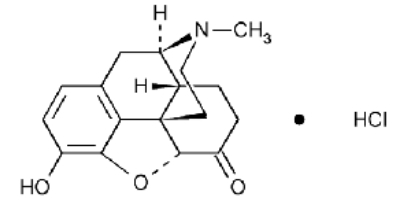
Hydromorphone hydrochloride is a white or almost white crystalline powder that is freely soluble in water, very slightly soluble in ethanol (96%), and practically insoluble in methylene chloride.
The inactive ingredients in Hydromorphone Hydrochloride Injection, USP include: 0.2% sodium citrate and 0.2% citric acid added as a buffer to maintain a pH between 3.5 and 5.5.
-
12 CLINICAL PHARMACOLOGY
12.1 Mechanism of Action
Hydromorphone is a full opioid agonist and is relatively selective for the mu-opioid receptor, although it can bind to other opioid receptors at higher doses. The principal therapeutic action of hydromorphone is analgesia. Like all full opioid agonists, there is no ceiling effect for analgesia with morphine. Clinically, dosage is titrated to provide adequate analgesia and may be limited by adverse reactions, including respiratory and CNS depression.
The precise mechanism of the analgesic action is unknown. However, specific CNS opioid receptors for endogenous compounds with opioid-like activity have been identified throughout the brain and spinal cord and are thought to play a role in the analgesic effects of this drug.
12.2 Pharmacodynamics
Effects on the Central Nervous System
Hydromorphone produces respiratory depression by direct effect on brain stem respiratory centers. The respiratory depression involves a reduction in the responsiveness of the brain stem respiratory centers to both increases in carbon dioxide tension and electrical stimulation.
Hydromorphone causes miosis, even in total darkness. Pinpoint pupils are a sign of opioid overdose but are not pathognomonic (e.g., pontine lesions of hemorrhagic or ischemic origin may produce similar findings). Marked mydriasis rather than miosis may be seen due to hypoxia in overdose situations.
Effects on the Gastrointestinal Tract and Other Smooth Muscle
Hydromorphone causes a reduction in motility associated with an increase in smooth muscle tone in the antrum of the stomach and duodenum. Digestion of food in the small intestine is delayed and propulsive contractions are decreased. Propulsive peristaltic waves in the colon are decreased, while tone may be increased to the point of spasm, resulting in constipation. Other opioid-induced effects may include a reduction in biliary and pancreatic secretions, spasm of sphincter of Oddi, and transient elevations in serum amylase.
Effects on the Cardiovascular System
Hydromorphone produces peripheral vasodilation which may result in orthostatic hypotension or syncope, manifestations of histamine release and/or peripheral vasodilation may include pruritus, flushing, red eyes, and sweating and/or orthostatic hypotension.
Effects on the Endocrine System
Opioids inhibit the secretion of adrenocorticotropic hormone (ACTH), cortisol, and luteinizing hormone (LH) in humans [see Adverse Reactions (6)]. They also stimulate prolactin, growth hormone (GH) secretion, and pancreatic secretion of insulin and glucagon.
Use of opioids for an extended period of time may influence the hypothalamic-pituitary-gonadal axis, leading to androgen deficiency that may manifest as low libido, impotence, erectile dysfunction, amenorrhea, or infertility. The causal role of opioids in the clinical syndrome of hypogonadism is unknown because the various medical, physical, lifestyle, and psychological stressors that may influence gonadal hormone levels have not been adequately controlled for in studies conducted to date [see Adverse Reactions (6)].
Effects on the Immune System
Opioids have been shown to have a variety of effects on components of the immune system in in vitro and animal models. The clinical significance of these findings is unknown. Overall, the effects of opioids appear to be modestly immunosuppressive.
Concentration–Efficacy Relationships
The minimum effective analgesic concentration will vary widely among patients, especially among patients who have been previously treated with opioid agonists. The minimum effective analgesic concentration of hydromorphone for any individual patient may increase over time due to an increase in pain, the development of a new pain syndrome, and/or the development of analgesic tolerance [see Dosage and Administration (2.1, 2.2)].
Concentration–Adverse Reaction Relationships
There is a relationship between increasing hydromorphone plasma concentration and increasing frequency of dose-related opioid adverse reactions such as nausea, vomiting, CNS effects, and respiratory depression. In opioid-tolerant patients, the situation may be altered by the development of tolerance to opioid-related adverse reactions [see Dosage and Administration (2.1, 2.2)].
12.3 Pharmacokinetics
Distribution
At therapeutic plasma levels, hydromorphone is approximately 8 to 19% bound to plasma proteins. After an intravenous bolus dose, the steady state of volume of distribution [mean (%CV)] is 302.9 (32%) liters.
Elimination
The systemic clearance is approximately 1.96 (20%) liters/minute. The terminal elimination half-life of hydromorphone after an intravenous dose is about 2.3 hours.
Metabolism
Hydromorphone is extensively metabolized via glucuronidation in the liver, with greater than 95% of the dose metabolized to hydromorphone-3-glucuronide along with minor amounts of 6-hydroxy reduction metabolites.
Excretion
Only a small amount of the hydromorphone dose is excreted unchanged in the urine. Most of the dose is excreted as hydromorphone-3-glucuronide along with minor amounts of 6-hydroxy reduction metabolites.
Special Populations
Hepatic Impairment
After oral administration of hydromorphone at a single 4 mg dose (2 mg hydromorphone immediate-release tablets), mean exposure to hydromorphone (Cmax and AUC∞) is increased 4-fold in patients with moderate (Child-Pugh Group B) hepatic impairment compared with subjects with normal hepatic function. Patients with moderate hepatic impairment should be started at one-fourth to one-half the recommended starting dose and closely monitored during dose titration. The pharmacokinetics of hydromorphone in patients with severe hepatic impairment has not been studied. A further increase in Cmax and AUC of hydromorphone in this group is expected and should be taken into consideration when selecting a starting dose [see Use in Specific Populations (8.6)].
Renal Impairment
The pharmacokinetics of hydromorphone following an oral administration of hydromorphone at a single 4 mg dose (2 mg hydromorphone immediate-release tablets) are affected by renal impairment. Mean exposure to hydromorphone (Cmax and AUC0-∞) is increased by 2-fold in patients with moderate (CLcr = 40 to 60 mL/min) renal impairment and increased by 4-fold in patients with severe (CLcr< 30 mL/min) renal impairment compared with normal subjects (CLcr> 80 mL/min). In addition, in patients with severe renal impairment, hydromorphone appeared to be more slowly eliminated with a longer terminal elimination half-life (40 hr) compared to patients with normal renal function (15 hr). Start patients with renal impairment on one-fourth to one-half the usual starting dose depending on the degree of impairment. Patients with renal impairment should be closely monitored during dose titration [see Use in Specific Populations (8.7)].
Geriatric Population
In the geriatric population, age has no effect on the pharmacokinetics of hydromorphone.
Sex
Sex has little effect on the pharmacokinetics of hydromorphone. Females appear to have a higher Cmax (25%) than males with comparable AUC0-24 values. The difference observed in Cmax may not be clinically relevant.
-
13 NONCLINICAL TOXICOLOGY
13.1 Carcinogenesis, Mutagenesis, Impairment of Fertility
Carcinogenesis
Long term studies in animals to evaluate the carcinogenic potential of hydromorphone have not been conducted.
Mutagenesis
Hydromorphone was positive in the mouse lymphoma assay in the presence of metabolic activation, but was negative in the mouse lymphoma assay in the absence of metabolic activation. Hydromorphone was not mutagenic in the in vitro bacterial reverse mutation assay (Ames assay). Hydromorphone was not clastogenic in either the in vitro human lymphocyte chromosome aberration assay or the in vivo mouse micronucleus assay.
Impairment of Fertility
Reduced implantation sites and viable fetuses were noted at 2.1 times the human daily dose of 32 mg/day in a study in which female rats were treated orally with 1.75, 3.5, or 7 mg/kg/day hydromorphone hydrochloride (0.5, 1.1, or 2.1 times a human daily dose of 24 mg/day (HDD) based on body surface area) beginning 14 days prior to mating through Gestation Day 7 and male rats were treated with the same hydromorphone hydrochloride doses beginning 28 days prior to and throughout mating.
-
16 HOW SUPPLIED/STORAGE AND HANDLING
Hydromorphone Hydrochloride Injection, USP is supplied in clear and colorless single-dose prefilled syringes. Each single-dose prefilled syringe of sterile, aqueous solution contains 0.2 mg, 0.5 mg, 1 mg or 2 mg hydromorphone hydrochloride with 0.2% sodium citrate and 0.2% citric acid solution.
Hydromorphone Hydrochloride Injection, USP contains no added preservative and is supplied as follows:
Unit of Sale
Strength
Each
NDC: 0641-6259-10
Unit of 10
0.2 mg/mL
1 mL single-dose prefilled syringe
NDC: 0641-6206-10
Unit of 10
0.5 mg/0.5 mL
0.5 mL single-dose prefilled syringe
NDC: 0641-6169-10
Unit of 10
1 mg/mL
1 mL single-dose prefilled syringe
NDC: 0641-6170-10
Unit of 10
2 mg/mL
1 mL single-dose prefilled syringe
PROTECT FROM LIGHT.
Store at 20° to 25°C (68° to 77°F); excursions permitted to 15° to 30°C (59° to 86°F) [See USP Controlled Room Temperature].
Safety and Handling Instructions
Discard any unused portion.
Access to drugs with a potential for abuse such as Hydromorphone Hydrochloride Injection, USP presents an occupational hazard for addiction in the health care industry. Routine procedures for handling controlled substances developed to protect the public may not be adequate to protect health care workers.
Implementation of more effective accounting procedures and measures to restrict access to drugs of this class (appropriate to the practice setting) may minimize the risk of self-administration by health care providers.
-
17 PATIENT COUNSELING INFORMATION
Addiction, Abuse, and Misuse
Inform patients that the use of hydromorphone hydrochloride injection, even when taken as recommended, can result in addiction, abuse, and misuse, which can lead to overdose and death [see Warnings and Precautions (5.1)].
Life-Threatening Respiratory Depression
Inform patients of the risk of life-threatening respiratory depression, including information that the risk is greatest when starting hydromorphone hydrochloride injection or when the dosage is increased, and that it can occur even at recommended dosages.
Hyperalgesia and Allodynia
Advise patients to inform their healthcare provider if they experience symptoms of hyperalgesia, including worsening pain, increased sensitivity to pain, or new pain [see Warnings and Precautions (5.5); Adverse Reactions (6)].
Serotonin Syndrome
Inform patients that opioids could cause a rare but potentially life-threatening condition called serotonin syndrome resulting from concomitant administration of serotonergic drugs. Warn patients of the symptoms of serotonin syndrome and to seek medical attention right away if symptoms develop after discharge from hospital. Instruct patients to inform their healthcare providers if they are taking, or plan to take serotonergic medications [see Drug Interactions (7)].
Constipation
Advise patients of the potential for severe constipation, including management instructions and when to seek medical attention [see Adverse Reactions (6)].
Healthcare professionals can telephone Hikma Pharmaceuticals USA Inc. at 1-877-845-0689 for information or to report adverse events on this product.
-
INSTRUCTIONS FOR USE
Figure 1: Outer Packaging and Prefilled Syringe

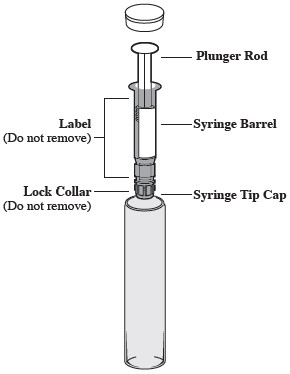
NOTES:
- Do not introduce any other fluid into the syringe at any time.
- Do not dilute for IV push.
- Do not re-sterilize the syringe.
- Do not use this product on a sterile field.
- This product is for single dose only.
1. Once removed from the bundle, inspect the outer packaging by verifying:
- Integrity of the tube and the cap.
- Tamper evident seal is intact.
Do not use if the outer packaging has been damaged.
2. Hold the outer packaging with both hands. To break the tamper evident seal, hold the tube and the cap close to the seal, and twist until broken. (See Figure 2)
Figure 2
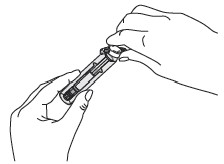
3. Remove the cap of the outer packaging by pulling it straight away from the tube.
4. Remove the syringe from the tube.
5. Visually inspect the syringe. Parenteral drug products should be inspected visually for particulate matter and discoloration prior to administration, whenever solution and container permit.
6. Push plunger rod slightly to break the stopper loose while tip cap is still on.
7. Twist off the syringe tip cap. (See Figure 3)
Figure 3
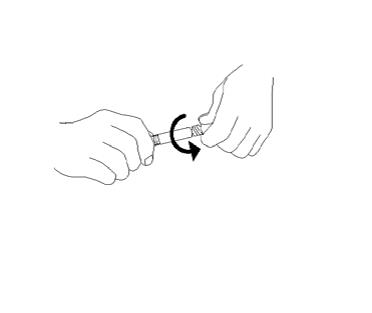
8. Expel air bubble(s). Adjust the dose (if applicable).
9. Administer the dose ensuring that pressure is maintained on the plunger rod during the entire administration.
10. Discard the used syringe into an appropriate receptacle.
For more information concerning this drug, please call Hikma Pharmaceuticals USA Inc. at 1-877-845-0689.
To report SUSPECTED ADVERSE REACTIONS, contact Hikma Pharmaceuticals USA Inc. at 1-877-845-0689 or FDA at 1-800-FDA-1088 or www.fda.gov/medwatch.
- SPL UNCLASSIFIED SECTION
-
PRINCIPAL DISPLAY PANEL
NDC 0641-6259-01 Rx only
1 mL Single-Dose Prefilled Syringe
HYDROmorphone HCI
Injection, USP CII
0.2 mg/mL
For SC, IM or slow IV USEProtect from light. Discard unused portion.
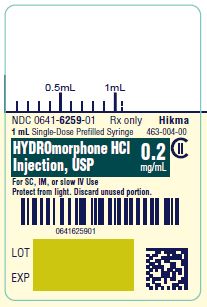
HYDROmorphone HCI
Injection, USP
0.2 mg/mL
NDC 0641-6259-10 Rx only
HYDROmorphone
HCl Injection, USP CII
0.2 mg per mL
For Subcutaneous, Intramuscular
or slow Intravenous Use.Do NOT dilute for IV push.
Do NOT place syringe on a Sterile Field.
10 x 1 mL Single-Dose Prefilled Syringes
Discard unused portion.
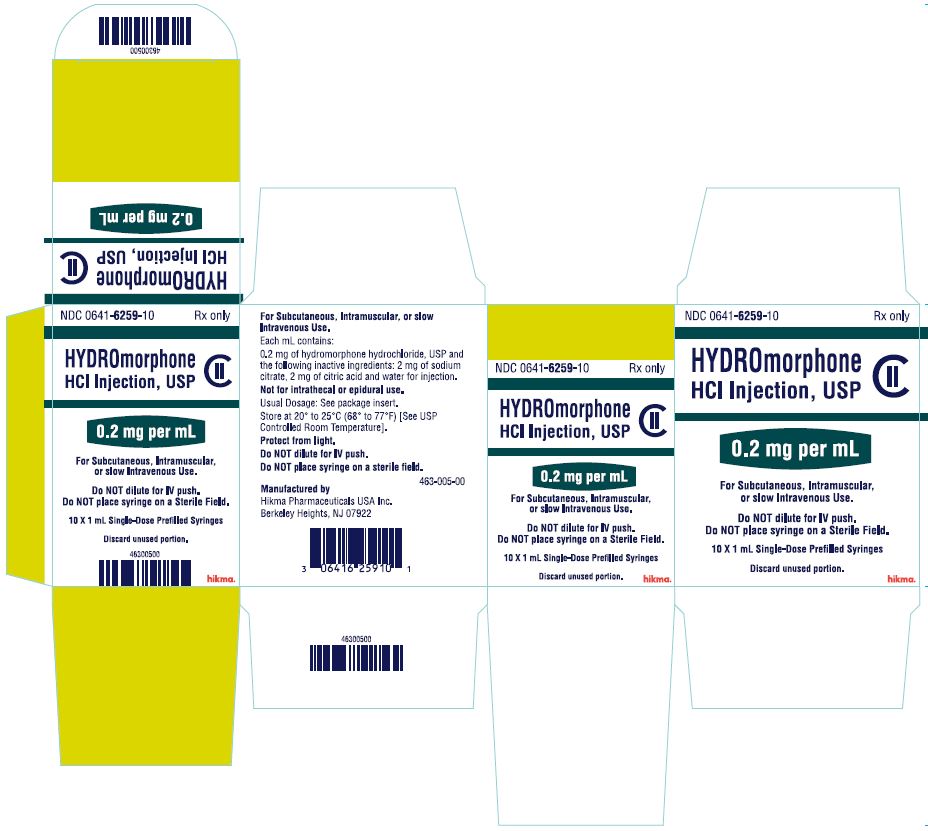
-
PRINCIPAL DISPLAY PANEL
NDC 0641-6206-01 Rx only
0.5 mL Single-Dose Prefilled Syringe
HYDROmorphone HCI
Injection, USP CII
0.5 mg/0.5 mL
For SC, IM or slow IV USEProtect from light. Discard unused portion.
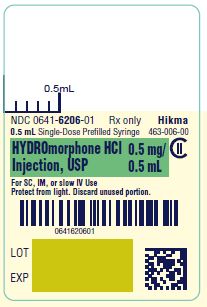
HYDROmorphone HCI
Injection, USP
0.5 mg/0.5 mL
NDC 0641-6206-10 Rx only
HYDROmorphone
HCl Injection, USP CII
0.5 mg per 0.5 mL
For Subcutaneous, Intramuscular
or slow Intravenous Use.Do NOT dilute for IV push.
Do NOT place syringe on a Sterile Field.
10 x 0.5 mL Single-Dose Prefilled Syringes
Discard unused portion.
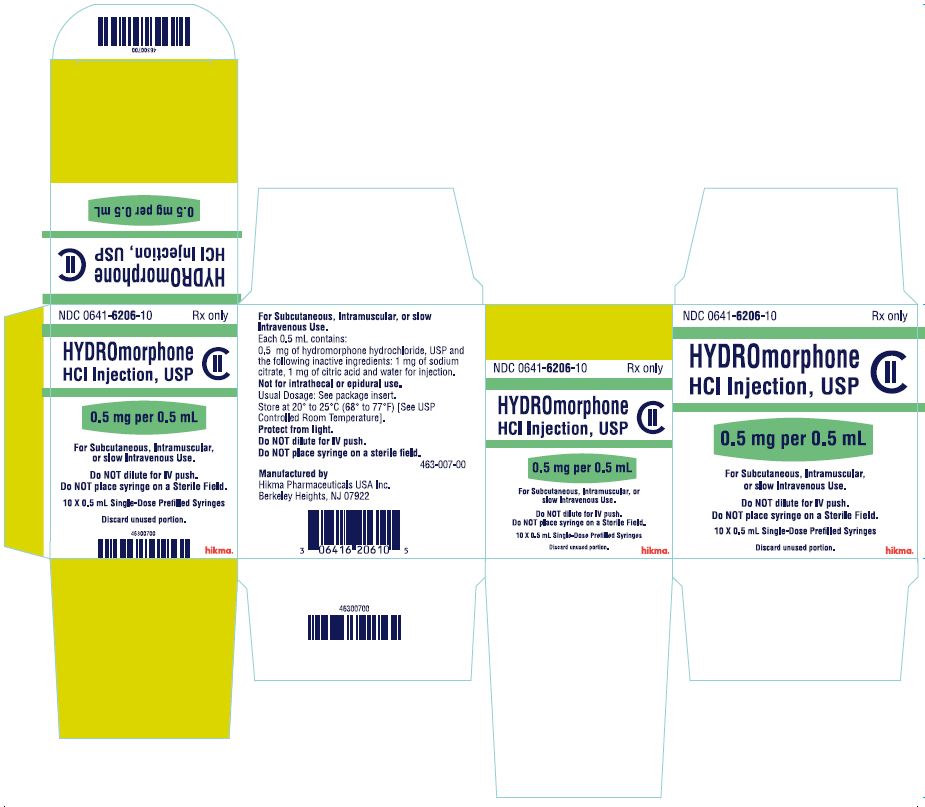
-
PRINCIPAL DISPLAY PANEL
NDC 0641-6169-01 Rx only
1 mL Single-Dose Prefilled Syringe
HYDROmorphone HCI
Injection, USP CII
1 mg/mL
For SC, IM or slow IV USEProtect from light. Discard unused portion.
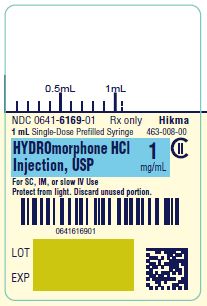
HYDROmorphone HCI
Injection, USP
1 mg/mL
NDC 0641-6169-10 Rx only
HYDROmorphone
HCl Injection, USP CII
1 mg per mL
For Subcutaneous, Intramuscular
or slow Intravenous Use.Do NOT dilute for IV push.
Do NOT place syringe on a Sterile Field.
10 x 1 mL Single-Dose Prefilled Syringes
Discard unused portion.
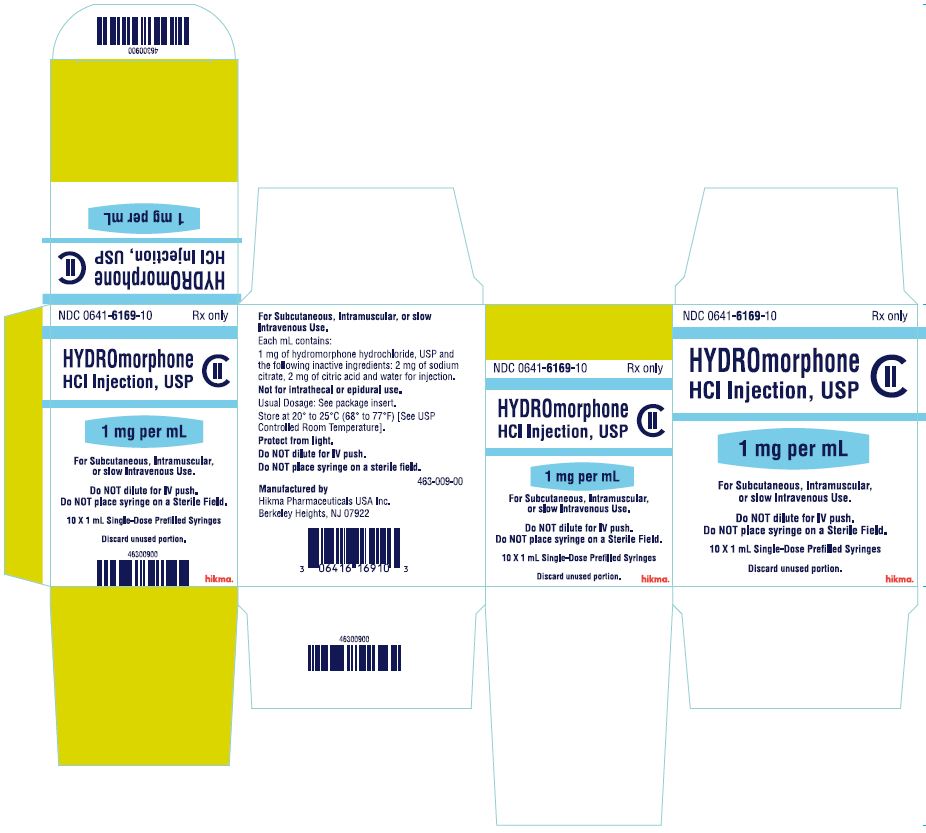
-
PRINCIPAL DISPLAY PANEL
NDC 0641-6170-01 Rx only
1 mL Single-Dose Prefilled Syringe
HYDROmorphone HCI
Injection, USP CII
2 mg/mL
For SC, IM or slow IV USEProtect from light. Discard unused portion.
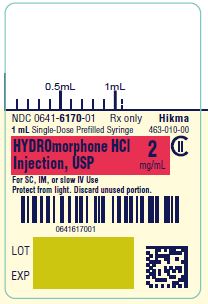
HYDROmorphone HCI
Injection, USP
2 mg/mL
NDC 0641-6170-10 Rx only
HYDROmorphone
HCl Injection, USP CII
2 mg per mL
For Subcutaneous, Intramuscular
or slow Intravenous Use.Do NOT dilute for IV push.
Do NOT place syringe on a Sterile Field.
10 x 1 mL Single-Dose Prefilled Syringes
Discard unused portion.
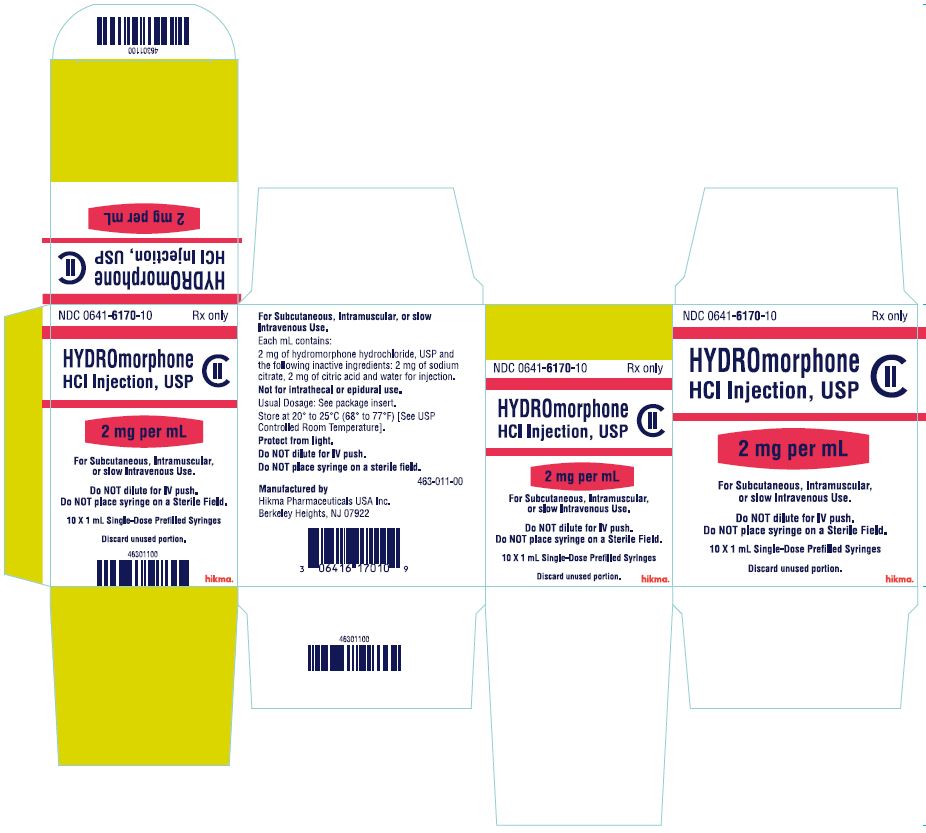
-
INGREDIENTS AND APPEARANCE
HYDROMORPHONE HYDROCHLORIDE
hydromorphone hydrochloride injectionProduct Information Product Type HUMAN PRESCRIPTION DRUG Item Code (Source) NDC: 0641-6170 Route of Administration INTRAMUSCULAR, INTRAVENOUS, SUBCUTANEOUS DEA Schedule CII Active Ingredient/Active Moiety Ingredient Name Basis of Strength Strength HYDROMORPHONE HYDROCHLORIDE (UNII: L960UP2KRW) (HYDROMORPHONE - UNII:Q812464R06) HYDROMORPHONE HYDROCHLORIDE 2 mg in 1 mL Inactive Ingredients Ingredient Name Strength SODIUM CITRATE (UNII: 1Q73Q2JULR) CITRIC ACID MONOHYDRATE (UNII: 2968PHW8QP) WATER (UNII: 059QF0KO0R) Packaging # Item Code Package Description Marketing Start Date Marketing End Date 1 NDC: 0641-6170-10 10 in 1 CARTON 04/26/2024 1 NDC: 0641-6170-01 1 mL in 1 SYRINGE; Type 2: Prefilled Drug Delivery Device/System (syringe, patch, etc.) Marketing Information Marketing Category Application Number or Monograph Citation Marketing Start Date Marketing End Date ANDA ANDA216899 04/26/2024 HYDROMORPHONE HYDROCHLORIDE
hydromorphone hydrochloride injectionProduct Information Product Type HUMAN PRESCRIPTION DRUG Item Code (Source) NDC: 0641-6206 Route of Administration INTRAMUSCULAR, INTRAVENOUS, SUBCUTANEOUS DEA Schedule CII Active Ingredient/Active Moiety Ingredient Name Basis of Strength Strength HYDROMORPHONE HYDROCHLORIDE (UNII: L960UP2KRW) (HYDROMORPHONE - UNII:Q812464R06) HYDROMORPHONE HYDROCHLORIDE 0.5 mg in 0.5 mL Inactive Ingredients Ingredient Name Strength SODIUM CITRATE (UNII: 1Q73Q2JULR) CITRIC ACID MONOHYDRATE (UNII: 2968PHW8QP) WATER (UNII: 059QF0KO0R) Packaging # Item Code Package Description Marketing Start Date Marketing End Date 1 NDC: 0641-6206-10 10 in 1 CARTON 04/26/2024 1 NDC: 0641-6206-01 0.5 mL in 1 SYRINGE; Type 2: Prefilled Drug Delivery Device/System (syringe, patch, etc.) Marketing Information Marketing Category Application Number or Monograph Citation Marketing Start Date Marketing End Date ANDA ANDA216899 04/26/2024 HYDROMORPHONE HYDROCHLORIDE
hydromorphone hydrochloride injectionProduct Information Product Type HUMAN PRESCRIPTION DRUG Item Code (Source) NDC: 0641-6169 Route of Administration INTRAMUSCULAR, INTRAVENOUS, SUBCUTANEOUS DEA Schedule CII Active Ingredient/Active Moiety Ingredient Name Basis of Strength Strength HYDROMORPHONE HYDROCHLORIDE (UNII: L960UP2KRW) (HYDROMORPHONE - UNII:Q812464R06) HYDROMORPHONE HYDROCHLORIDE 1 mg in 1 mL Inactive Ingredients Ingredient Name Strength SODIUM CITRATE (UNII: 1Q73Q2JULR) CITRIC ACID MONOHYDRATE (UNII: 2968PHW8QP) WATER (UNII: 059QF0KO0R) Packaging # Item Code Package Description Marketing Start Date Marketing End Date 1 NDC: 0641-6169-10 10 in 1 CARTON 04/26/2024 1 NDC: 0641-6169-01 1 mL in 1 SYRINGE; Type 2: Prefilled Drug Delivery Device/System (syringe, patch, etc.) Marketing Information Marketing Category Application Number or Monograph Citation Marketing Start Date Marketing End Date ANDA ANDA216899 04/26/2024 HYDROMORPHONE HYDROCHLORIDE
hydromorphone hydrochloride injectionProduct Information Product Type HUMAN PRESCRIPTION DRUG Item Code (Source) NDC: 0641-6259 Route of Administration INTRAMUSCULAR, INTRAVENOUS, SUBCUTANEOUS DEA Schedule CII Active Ingredient/Active Moiety Ingredient Name Basis of Strength Strength HYDROMORPHONE HYDROCHLORIDE (UNII: L960UP2KRW) (HYDROMORPHONE - UNII:Q812464R06) HYDROMORPHONE HYDROCHLORIDE 0.2 mg in 1 mL Inactive Ingredients Ingredient Name Strength SODIUM CITRATE (UNII: 1Q73Q2JULR) CITRIC ACID MONOHYDRATE (UNII: 2968PHW8QP) WATER (UNII: 059QF0KO0R) Packaging # Item Code Package Description Marketing Start Date Marketing End Date 1 NDC: 0641-6259-10 10 in 1 CARTON 04/26/2024 1 NDC: 0641-6259-01 1 mL in 1 SYRINGE; Type 2: Prefilled Drug Delivery Device/System (syringe, patch, etc.) Marketing Information Marketing Category Application Number or Monograph Citation Marketing Start Date Marketing End Date ANDA ANDA216899 04/26/2024 Labeler - Hikma Pharmaceuticals USA Inc. (946499746)
© 2025 FDA.report
This site is not affiliated with or endorsed by the FDA.